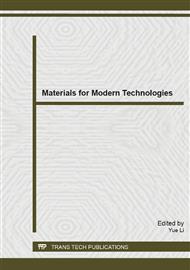[1]
S. Sato, T. Nomura, and A. Sato. Dielectric ceramic composition and electronic device. United States Patent: 6226172, (1999).
Google Scholar
[2]
Y.S. Jung, E.S. Na, U. Paik, J. Lee, J. Kim, Mater. Res. Bull. 37(9), 1633 (2002).
Google Scholar
[3]
I. Kazushige, and S. Akira. Dielectric ceramic composition and electronic device. United States Patent: 7262146, (2007).
Google Scholar
[4]
D. Flandre, A.N. Nazarov, and P.L.F. Hemment, Science and technology of semiconductor-on-insulator structures and devicesoperating in a harsh environment. 2005, London: Kluwer Academic Publisher. 1.
Google Scholar
[5]
P.G. Neudeck, R.S. Okojie, L. -Y. Chen, P. Ieee. 90(6), 1065 (2002).
Google Scholar
[6]
J.L. Evans, P. Jacobsen, R. Thompson, and R. Wayne Johnson. High temperature automotive electronics. 2002. Reno, NV, United States: The International Society for Optical Engineering.
Google Scholar
[7]
R.W. Johnson, J.L. Evans, P. Jacobsen, J.R. Thompson, M. Christopher, IEEE Transactions on Electronics Packaging Manufacturing 27(3), 164 (2004).
Google Scholar
[8]
S. Gao, S. Wu, Y. Zhang, H. Yang, and X. Wang, Study on the Microstructure and Dielectric Properties of X9R Ceramics Based on BaTiO3, Materials Science and Engineering: B, 176.
DOI: 10.1016/j.mseb.2010.09.004
Google Scholar
[1]
68-71 (2011).
Google Scholar
[9]
D. Prakash, B. P. Sharma, T. R. R. Mohan, and P. Gopalan, Flux Additions in Barium Titanate: Overview and Prospects, J. Solid State Chem., 155, 86–95 (2000).
DOI: 10.1006/jssc.2000.8895
Google Scholar
[10]
L. Sheppard, Progress Continues in Capacitor Technology, Am. Ceram. Soc. Bull., 72, 44-57 (1993).
Google Scholar
[11]
L. Benziada, J. Ravez, Ferroelectric BaTiO3 the aid ceramics sintered at low temperature with of a mixture of CaF2 and LiF, , Journal of Fluorine Chemistry 73 (1995) 69-71.
DOI: 10.1016/0022-1139(94)03211-h
Google Scholar
[12]
G.A. Khater, Influence of Cr2O3, LiF, CaF2 and TiO2 nucleants on the crystallization behavior and microstructure of glass-ceramics based on blast-furnace slag, , Ceramics International 37 (2011) 2193–2199.
DOI: 10.1016/j.ceramint.2011.03.011
Google Scholar
[13]
Randall M. German, Pavan Suri and Seong Jin Park, Review: liquid phase sintering, J. Mater. Sci., (2009) 44: 1-39.
Google Scholar
[14]
J. Suchanicz, M.G. Gavshin, A.Y. Judzin, and C.Z. Kus, J. Mater. Sci. 36, 1981 (2001).
Google Scholar


